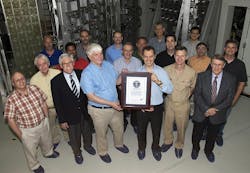IMAGE: Researchers at the U.S. Naval Research Laboratory (NRL), Nike krypton fluoride laser facility, are the recipients of the Guinness World Records certificate for "Highest Projectile Velocity." Pictured from left to right: James (Jim) Weaver, Yefim Aglitskiy, Bruce Jenkins, Thomas (Tom) Mehlhorn, Jude Kessler, Dennis Brown, Stephen (Steve) Obenschain, Jason Bates, Victor Serlin, Steve Krafsig, Max Karasik, Lop-Yung Chan, Stephen (Steve) Terrell, Capt. Anthony Ferrari, Jaechul Oh, Sasha Velikovich, John Montgomery, and David Kehne. (Image credit:U.S. Naval Research Laboratory/Jamie Hartman)
The Nike krypton fluoride (KrF) laser at the U.S. Naval Research Laboratory (NRL; Washington, DC) has earned the coveted Guinness World Records title for achieving "Highest Projectile Velocity" of greater than 1,000 km/s, a speed equivalent to two-and-a-quarter million miles per hour.
RELATED ARTICLE: On-chip DLA is precursor to tabletop particle accelerator
The previous record was held by researchers at Osaka University's Institute of Laser Engineering in Japan, who in 2006 used a neodymium glass (Nd:glass) laser to accelerate a target to 700 km/s. The record, currently held by NRL, was achieved in collaboration with the NRL Plasma Physics Division and the group from Japan, demonstrating the advantages of the high uniformity and short wavelength of the KrF laser technology.
"The impact of the highly accelerated target on a stationary foil generated thermonuclear fusion neutrons whose energy spread indicated that a gigabar--that's the pressure of a billion atmospheres--was achieved in the collision," said Max Karasik, NRL Laser Plasma Branch. "The results highlight the advantages of a krypton-fluoride laser in efficiently generating uniform pressures required for fuel compression in inertial confinement fusion."
In the experiments, thin plastic foils were accelerated to 1,000 km/s over a distance of less than a millimeter. The moving foils then collided with a stationary foil, generating thermo-nuclear temperatures and neutrons from fusion reactions. The high ablative pressure applied to compress and accelerate targets is used in inertial confinement fusion and high energy density research.
NRL received the official Guinness World Records certificate, February 2014, with distinction given to the research that "...probe[s] possibilities for future clean-energy sources." However, since the 2009 experiment, Karasik says NRL has raised the bar. With an improved laser pulse shape, researchers at the Nike laser facility have reached target velocities of 1,180 km/s.
Sponsored by the Department of Energy National Nuclear Security Administration, the Nike laser is a 2-3 kJ KrF system that incorporates beam smoothing by induced spatial incoherence (ISI) to achieve one percent non-uniformity in single beams and 0.16% non-uniformity for 44 overlapped target beams. The facility routinely conducts experiments in support of inertial confinement fusion, laser-matter interactions, and high energy density physics.
SOURCE: NRL; http://www.nrl.navy.mil/media/news-releases/2014/nrl-nike-laser-achieves-spot-in-guinness-world-records
